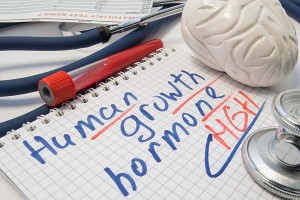In this article
The deficiency of human growth hormone (HGH) is an endocrine disorder that develops due to the inadequate function of the pituitary gland.
Growth hormone deficiency (GHD) can affect children and adults alike. In children, HGH is crucial for their growth so GHD manifests with short height and failure to thrive. As an adult, you also need growth hormone as it regulates your metabolism, body composition, mood, and more.

Unfortunately, doctors rarely consider AGHD and test for it, as the symptoms can be caused by many other conditions. In fact, AGHD is a rare condition with an annual incidence of 1.2 per 100 000 adults.
Currently, 1 in every 10 000 people are affected by the condition and the most common cause of adult-onset GHD is a pituitary tumor with unknown etiology.
Symptoms of AGHD
But how to know if you have developed adult-onset GHD? The symptoms you may experience are rather nonspecific and may be caused by many different conditions.

The most common signs of GHD in adults include:
- Abdominal obesity
- Muscle loss
- Chronic fatigue
- Reduced strength and endurance
- Hypercholesterolemia
- Bone loss
- Cognitive and mood problems
- Reduced quality of life
The main difference in terms of symptoms between AGHD and childhood-onset GHD is that the decline in growth and short height are usually the first and often the only sign of a deficiency. Instead, the most common symptoms in patients with AGHD are changes in body composition and energy levels.
What are the early signs of AGHD?
Usually, the first signs in adults appear within a few weeks or months after the onset of the condition and often progress continuously over the course of the next months or even years.
These symptoms include muscle loss, increased abdominal fat, and chronic fatigue
Patients also frequently complain of emotional lability, and mental fatigue, resulting in a low perceived quality of life.
Studies suggest that increased cholesterol levels are relatively common, affecting 29-45% of patients with adult-onset GHD. The cardiovascular system may also get affected, mainly due to the unfavorable effects of GHD on the lipid profile, which leads to hypercholesterolemia and atherosclerosis.
Long-term GHD can also lead to reduced bone mineral density in about 11-30% of patients with adult-onset.
Thus, the most commonly affected organs and systems in the body include muscles, bone, and the cardiovascular system.
In fact, some nationwide studies report that in comparison to healthy controls, adults with GHD have increased mortality due to heart diseases. That’s because of abdominal obesity which develops in GHD patients and is a major risk factor for cardiovascular problems.
Furthermore, patients can develop osteoporosis and related complications due to GHD-associated bone loss.
2 main causes of AGHD
Depending on the cause of adult-onset GHD, it can be classified as either acquired or idiopathic. According to research, 80-90% of the cases of AGHD are acquired.
Acquired AGHD develops when there is another disease or pathological condition which damages the pituitary gland and causes the deficiency. Such conditions include:
- Tumors (both pituitary and extra pituitary)
- Brain hemorrhage
- Pituitary apoplexy
- Brain injury
- Infections affecting the pituitary
- Inflammation and autoimmune conditions affecting the pituitary
- Pituitary damage due to surgery
- Radiation
Benign pituitary tumors such as adenomas are the most common cause of acquired AGHD and account for 60-70% of all cases.
If the cause of GHD is a tumor, there can be other complaints as well, such as headaches, partial loss of vision, menstrual problems in women, and erectile dysfunction in men.
The current cause for the formation of pituitary adenomas is unknown, although many scientists think that genetic factors may play a role in their development. Thus, there may be a higher risk of developing AGHD in certain families.
Adult-onset GHD is not considered a hereditary condition
Other causes such as infections, hemorrhages, or injuries may lead to additional symptoms such as vomiting, vertigo, paralysis, fever, loss of consciousness, and many more.
If the cause of the deficiency cannot be found, then the condition is classified as idiopathic adult GH deficiency.
It is much less common in adults compared to acquired AGHD and it poses a significant diagnostic challenge. That’s because there are no accompanying symptoms from any condition that could cause pituitary damage and trigger the deficiency.
How is growth hormone deficiency diagnosed?
If you suspect that you may have GHD, then you should first consult with a medical doctor who specializes in endocrinology.

The standard is to use a provocation test which stimulates a peak in GH levels. If the pituitary gland cannot produce a normal peak under the stimulus, this indicates GHD.
The provocation test can be performed using medications such as insulin, glucagon, or a combination of growth hormone-releasing hormone (GHRH) and arginine.
All provocation tests must be performed in medical settings and by experienced medical personnel.
Insulin Tolerance Test (ITT)
ITT is the gold standard as it provides the most reliable results. It works by lowering your blood sugar to 2.2 mmol/l (40 mg/dl) which triggers an HGH peak.
If your HGH peak does not reach at least 5.1 ng/ml during the ITT this is a strong indication that you have GHD.
Yet, lowering blood sugar also has contraindications such as advanced age, heart problems, and epilepsy. In such cases, using another test would be safer.
Glucagon Stimulation Test (GST)
According to the latest research, the glucagon stimulation test is currently the method of choice if ITT is contraindicated. However, the mechanisms by which glucagon-induced GH stimulation occurs is unclear.
The downside of the GST is that it is less accurate in patients with obesity and/or insulin resistance. Thus, the cut-off point for GHD diagnosis in people with normal BMI is less than 3.1 ng/ml, while the cut-off point for obese patients is less than 1.1 ng/ml.
GHRH-arginine test
The GHRH-arginine test is no longer recommended as an alternative to the ITT. That’s because GHRH is no longer commercially available in the US. The cut-off point for this test in obese individuals was less than 4.1 ng/ml.
Alternatively, there is a novel secretagogue called Macimorelin which stimulates the release of HGH by triggering the ghrelin receptors. The result is not significantly affected by obesity and the cut-off point for GHD diagnosis is less than 2.9 ng/ml.
If you have GHD, then your doctor can prescribe you HGH therapy that will help you manage all your symptoms and restore your quality of life.
How to treat GHD in adults
Currently, the only FDA-approved treatment for GHD is growth hormone replacement therapy. It involves injections with recombinant human growth hormone which has an identical structure to the one naturally produced in the human body.
Medical doctors and endocrinologists have successfully applied HGH therapy in the treatment of children and adults alike. In fact, HGH treatment allows children and adolescents with GHD to achieve their final height and manage all other complaints related to the condition.
Furthermore, HGH injections are the only effective form of treatment that can successfully manage the symptoms of GHD. No other class of medications or dietary supplement has shown comparable effectiveness, especially in patients who have severe GHD.
Injections are also the only reliable method for administering recombinant HGH in the human body. Taking growth hormone orally inactivates it in the stomach, while the transdermal absorption of the hormone is negligible.
HGH injections have a good safety profile. Yet, there is potential for abuse, and taking too much HGH can lead to side effects. That’s why injections are available only with a prescription and should be taken under medical supervision.
How to get legal HGH injections
The process for getting HGH injections is not any more complicated for adults than for children. It goes through 5 simple steps:
- Medical consultation with an endocrinologist for symptom evaluation
- Undergoing laboratory tests including provocation tests
- Secondary medical consultation with an endocrinologist to evaluate your results, discuss therapeutic options and provide you with a prescription
- Purchasing the medication from licensed pharmacies which require a prescription
- Receiving HGH injections following the administration guidelines given by your doctor
Once you have the prescription, it is up to you to decide whether you’d like to choose the therapy or live with the symptoms
Thankfully, HGH therapy can help you manage all the symptoms and return to your previous quality of life. Thus, the value of treatment significantly outweighs the cost of HGH therapy.
You can also avoid any side effects, as long as you receive genuine HGH purchased with a prescription, and you are under strict monitoring by an endocrinologist.
At our clinic, you can receive HGH therapy at a competitive price as well as medical guidance from experienced specialists in endocrinology, who will guarantee the safety and effectiveness of your treatment.
